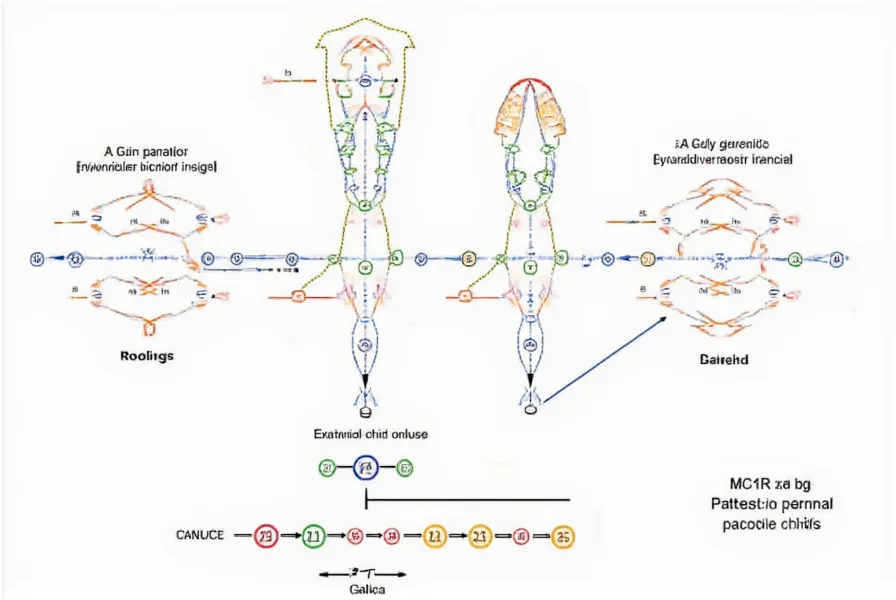Red hair represents one of humanity's most distinctive genetic traits, instantly recognizable yet relatively rare worldwide. The characteristic ginger hue stems from a specific mutation in the melanocortin-1 receptor (MC1R) gene that affects pigment production. Unlike other hair colors that contain varying ratios of eumelanin (brown-black pigment) and pheomelanin (red-yellow pigment), ginger hair contains predominantly pheomelanin with minimal eumelanin.
The Genetic Basis of Ginger Hair
Ginger hair follows an autosomal recessive inheritance pattern, meaning both parents must carry the variant MC1R gene for their child to potentially express red hair. Carriers with only one copy typically don't show red hair themselves but can pass the gene to offspring. Scientists have identified more than 20 different MC1R variants associated with red hair, explaining the spectrum of shades from copper to deep burgundy.
| Country/Region | Red Hair Prevalence | Notable Genetic Factors |
|---|---|---|
| Scotland | 13% | Highest concentration of MC1R variants |
| Ireland | 10% | Strong Celtic genetic influence |
| Wales | 6% | Higher than European average |
| United States | 2-6% | Primarily from British/Irish ancestry |
| Global Average | 1-2% | Rarest natural hair color worldwide |
Unique Characteristics of Ginger Hair
Ginger hair differs structurally from other hair colors. Each strand contains more pheomelanin, which creates not only the distinctive color but also affects hair texture. Many redheads report thicker individual strands but fewer total hairs compared to brunettes or blondes. The pigment sits closer to the hair's surface, making it more susceptible to fading from sun exposure and chemical treatments.
Redheads often experience heightened sensitivity to certain stimuli. Research indicates they may require up to 20% more anesthesia during medical procedures due to MC1R gene effects on pain perception. They also face increased risk of skin cancer due to reduced melanin protection, necessitating rigorous sun protection measures.

Cultural Perceptions Throughout History
Cultural attitudes toward ginger hair have fluctuated dramatically across time and geography. Ancient Greeks associated red hair with barbarians, while medieval Europeans sometimes linked it to witchcraft or vampirism. In contrast, ancient Egyptians considered red hair sacred, depicting deities like the sun god Ra with fiery locks.
Modern Western culture shows increasing acceptance of red hair, though stereotypes persist. Scotland and Ireland have embraced red hair as part of national identity, with events like Ireland's Redhead Day celebrating this distinctive trait. Contemporary media representation has improved, though redheads still face disproportionate bullying in some regions.
Specialized Care for Ginger Hair
Maintaining vibrant ginger hair requires specific approaches. The copper tones fade more quickly than other colors when exposed to UV radiation, so redheads benefit from UV-protective hair products. Sulfate-free shampoos help preserve color intensity, while purple-toned products counteract brassiness that can develop over time.
Professional colorists recommend avoiding frequent dyeing, as ginger hair's unique structure makes it more vulnerable to damage. When coloring is necessary, specialists suggest using semi-permanent dyes specifically formulated for red tones rather than attempting to cover natural red with darker shades, which often results in undesirable orange undertones.
Common Misconceptions About Redheads
Several myths about redheads persist despite scientific evidence to the contrary. The notion that redheads are going extinct represents perhaps the most widespread misconception. While the recessive nature of the MC1R variant means red hair could become less common, complete extinction remains genetically impossible as long as carriers exist.
Another persistent myth suggests redheads bleed more or have different blood composition. Medical research shows no evidence supporting this claim. Similarly, the idea that all redheads have blue eyes represents another common misconception; while the traits sometimes co-occur due to shared Celtic ancestry, red hair appears with all eye colors.
Practical Considerations for Redheads
Individuals with ginger hair should prioritize sun protection due to increased skin cancer risk. Dermatologists recommend daily broad-spectrum SPF 30+ sunscreen, protective clothing, and regular skin checks. For hair maintenance, specialists suggest using color-depositing conditioners between salon visits to refresh fading tones.
Those considering permanent hair color changes should consult specialists familiar with red hair's unique challenges. Attempting to cover natural red often requires multiple sessions and professional expertise to avoid unwanted results. Many colorists recommend embracing natural red tones rather than fighting them for the healthiest hair outcome.










 浙公网安备
33010002000092号
浙公网安备
33010002000092号 浙B2-20120091-4
浙B2-20120091-4